Email best practices
How do triggered emails work? Examine these 6 case studies
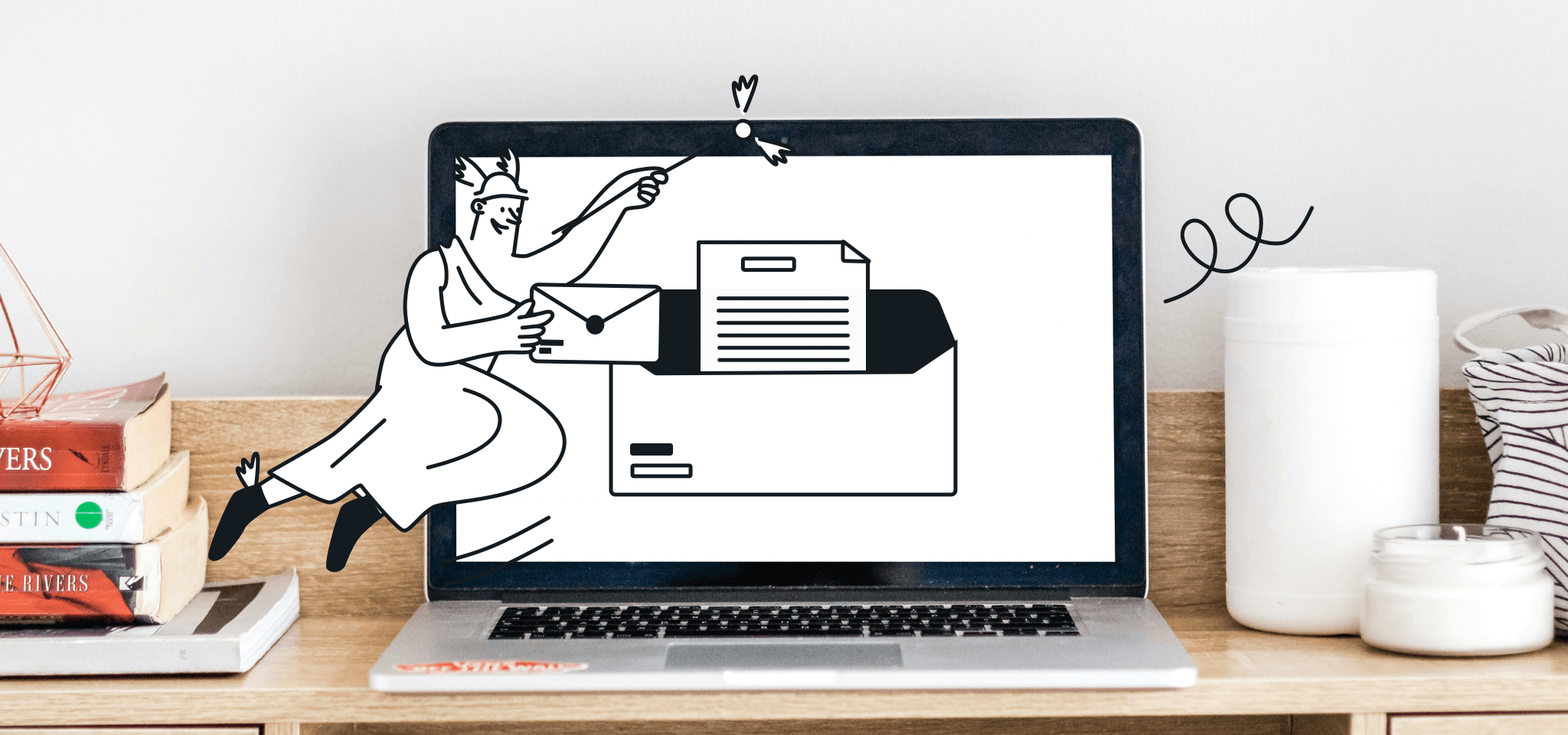
Email best practices

A triggered email is like a self-driving car – once it’s set up, you can simply take your hands off the wheel. Triggered emails, including order confirmations, are the nuts and bolts of email communication. They give customers peace of mind and trust in your operations, while giving you the chance to collect feedback or up-sell.
As marketers, we have email campaigns and a million other things to take care of, so triggered emails can be a welcome break. But triggered emails come in all shapes and sizes. There are triggers for welcome emails, reactivations, cart abandonment, events, feedback, and recommendations – the list goes on… Depending on a company’s size, a marketer can have dozens of active triggers set at once.
So how do you choose the right trigger to fit your needs? We’ll cover some examples of the most popular triggered emails available and why they’re so effective.
Triggered emails are also known as behavioral or transactional emails. These are emails that are automatically sent to an individual. The individual must meet predefined parameters or conditions to trigger the email through specific actions, behaviors, or other signals. One key aim of triggered emails is to inform customers and confirm that the company or website they have subscribed to is a dependable brand.
The primary difference between triggered emails and other generic promotional emails is that triggered emails are automatically sent to the subscriber on a one-to-one basis. On the other hand, general promotional emails are sent on a one-to-many basis. Research has shown that triggered emails can significantly help businesses grow their return on investment (ROI) compared to generic emails. This makes triggered emails important in making your customers buy from you constantly.
Let’s explore a few case studies that show how triggered emails can work for your marketing campaigns.
This type of triggered email is received by the user when they complete the subscription process. They also automatically join the mailing list to whatever they subscribed for. A welcome email usually has a thankful tone. It seeks to engage the recipient, creates a positive first impression, and promises more value in the future.
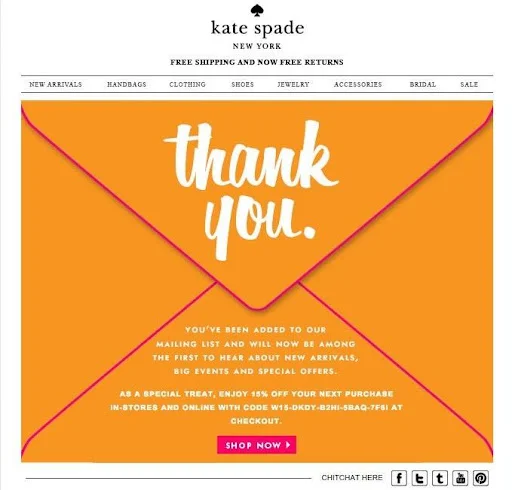
Kate Spade thank their customers with a discount code.
This email is the first step towards establishing a relationship between the brand and the customer. Make sure to include details about the business and any other relevant information in a welcome email. Triggered emails, including welcome emails, are a powerful tool in email marketing and content marketing as a whole. You should take advantage of them.
Welcome emails can also include a call-to-action that will lead the new subscriber to other various content worth discovering. At the same time, it mustn’t have too much information as this might put off the subscriber.
A great example is how PeakDesign achieved more than 70% open rate on the first email for their onboarding campaign. The first email was sent 30 minutes after purchasing/subscribing. The second email was sent after seven days. Each email provided the customer tips on how to use gear they had just bought.
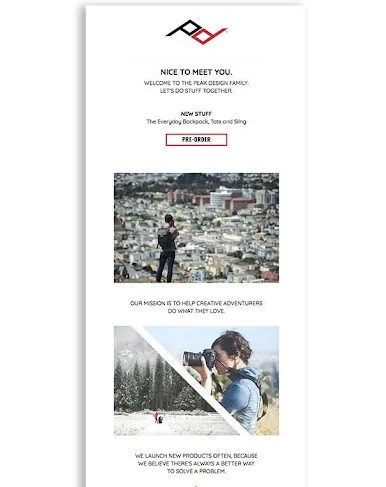
PeakDesign welcomes customers with a visual email.
The results were that the first email (above) had a 72% open rate and the second had 64%. Over a 12-month period, PeakDesign generated $150k through their well thought out welcome emails.
Between juggling a job, family responsibilities, and other daily activities, it’s easy for your customers to forget about your product or service. That’s why reactivation emails have become very important. It’s in the business’s best interests to think creatively on how to win back lost attention.
With more websites popping up every day, competition is stiffer. Achieving top-of-mind awareness has become an important goal for every business.

Win back customer’s attention with a reactivation email.
You can craft a re-engagement campaign that sends a message to users after a certain number of inactive days. Sending a reactivation email to your customers will serve as a reminder about your brand. It will also remind them about any other added value you have to offer. This can also be a chance for the recipient to opt-out of further emails.
SurfStitch sends out a packed re-engagement email that will have the customer having a case of FOMO. All the information that the lapsed customer might want to know is available on one email. Each tab has its own unique call-to-action, making it easy to navigate.
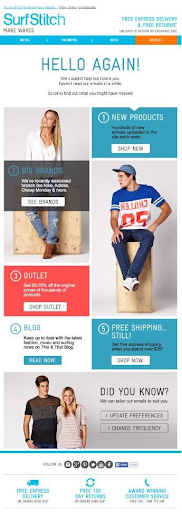
Surfstitch scatters CTAs throughout their reactivation email.
In addition, the value propositions are added to remind the customer of the awesome deals they are missing out on. The email contains the right amount of information to trigger re-activation. Customers get to also choose the frequency of any subsequent emails.
Order confirmation triggered emails are sent after a customer’s purchase order has been confirmed and finalized. This email is triggered upon purchase completion and once the delivery order information has been recorded (shipping, details, etc.).
With order confirmation triggered emails, online shopping websites can effectively engage customers. They also get the chance to alert their customers with appropriate messages at the right time. All this provides for a great customer experience.
The order confirmation triggered email should be courteous, it should thank your customers for trusting your brand, and confirm what they have purchased.
This triggered email can be followed by periodical after-sales emails that keep customers updated about their purchases. You can also send product recommendations with follow-up emails.
One Ukrainian fashion brand struck (email) gold after it started sending out confirmation emails. Most of their orders were done outside working hours and it was crucial to alert customers of the successful buy order.
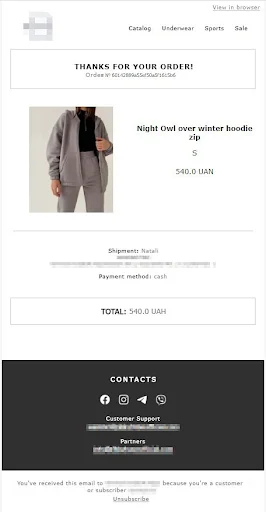
Sputnik’s order confirmation email creates trust from the customer.
The main reason for this email was to build a relationship with the customer, enhancing the company’s professional image. This new technique resulted in almost a 50% open rate for all confirmation emails sent and led to a nearly 5% surge in repeat sales over a one-month period.
Shopping cart abandonment is a massive challenge for nearly all eCommerce businesses. This makes cart abandonment emails one of the most important emails to get right. Shopping cart abandonment happens when customers add items to their shopping cart but leave the shopping site without completing the purchase. You can send a triggered email for an abandoned cart after a certain period of inactivity to try to recover the sale.
A small survey can also accompany triggered emails for abandoned carts to try and find out why the customer did not complete the purchase. This data can then be used to improve the user experience.
A simple reminder can quickly get the customer back to the shopping site to complete the purchase. Funny, witty, and casual copy is the way to your customer’s heart. The example below from Dote excels at having all the elements needed to engage the customer. In this case, Dote uses their dry brand of humor to nudge the customer towards completing their purchase. This example shows how you can use abandoned cart emails to demonstrate your brand personality.
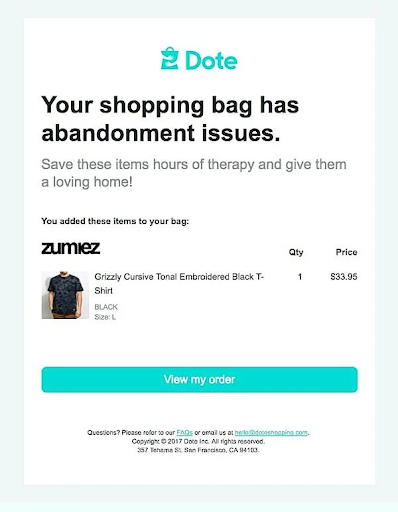
Dote’s cart abandonment email is funny, witty, and casual.
If the customer does not react to the first email, send another within 24 hours. You can send a third email following three to five days. Anything more than three will become irritating for the customer.
Well-crafted abandoned cart emails can increase re-engagement by up to 6%. Sending that email reminding your customer that they left something could help them decide if they want their items after all.
These are triggered birthday emails that are sent to celebrate a subscriber’s birthday. To send this email, you will need to gather the subscriber’s birth dates.
Triggered emails for birthdays are a great way to connect with the subscriber intimately. Such personalized messages show your appreciation and thoughtfulness. This will help create a customer base that is loyal to your brand. Generic messages aren’t as effective anymore – therefore, you need to develop tailored messages for each individual. Such messages help with customer retention.
You can go further with the birthday celebrations by giving the subscriber a discount or gift card for their next purchase. When sending out birthday emails, Nike keeps it simple but memorable. The Nike shoe box acts as their birthday gift –a very subtle call-to-action which immediately triggers the customer to open the box.
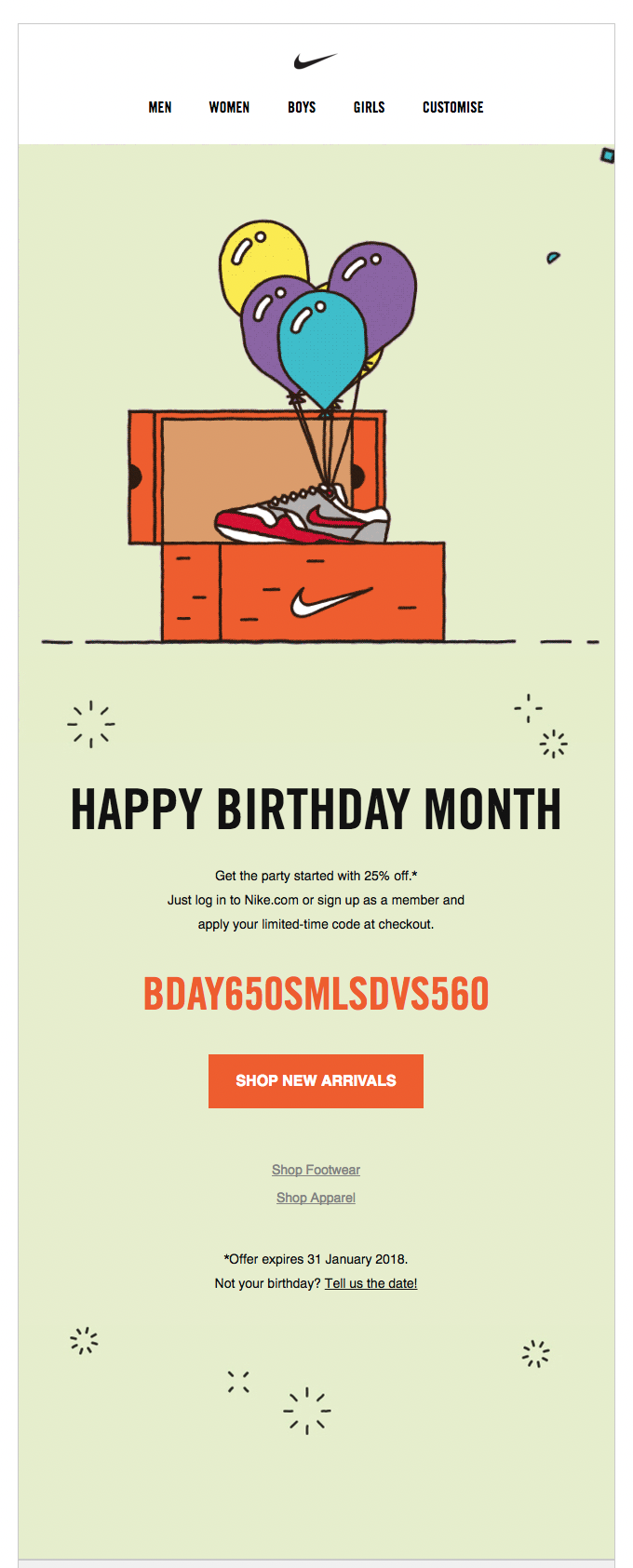
Nike’s fun birthday surprise for customers.
Such tailored messages result in high click-through rates and increased revenue from each individual email.
These emails are meant to gather data from your subscribers. This data can then improve the user experience, user interface, or even improve communication between your brand and the customers.
Feedback and recommendation emails shouldn’t be used to “just tick a box”. Companies have to take into consideration the feedback they have received seriously. This will help them to improve their products and services continuously.
Feedback emails are a great source of customer feedback insights. By tweaking how your feedback emails look like you can get some really valuable information. Personalization is important in order to get the best results.
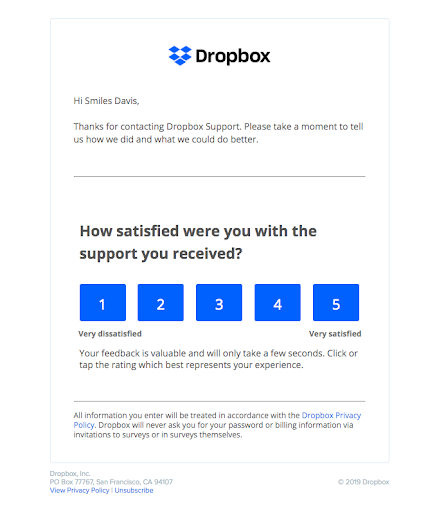
Dropbox uses interactive boxes to request feedback from customers.
Using the data you gather from these survey emails, you can segment your audience more accurately, send them more relevant content, and increase your click-through and conversion rates.
Triggered emails can positively impact your revenue. However, you must have a strategic plan on how you use them because too many of them will end up harming your business. The idea is to engage and retain, not to spam and push away.
There are many other types of triggered emails, and you can read up on these to find out which ones suit your business. Take time to explore opportunities brought by email marketing campaigns and be flexible in your implementation.
Results can also take a while before showing, so be patient with your strategy. Remember that you also need adequate resources for effective campaigns, so start small and scale up as you go.
Want to learn more about email best practices? Sign up for our newsletter and get tips and insights in your inbox every week!